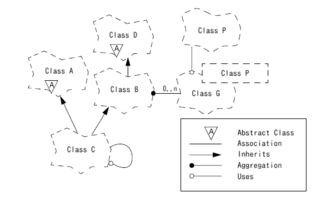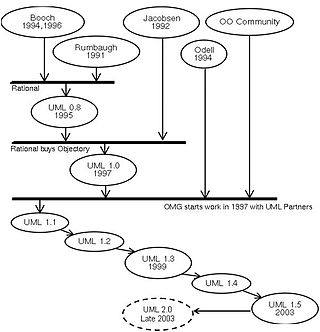Related Research Articles

The Booch method is a method for object-oriented software development. It is composed of an object modeling language, an iterative object-oriented development process, and a set of recommended practices.

An object-modeling language is a standardized set of symbols used to model a software system using an object-oriented framework. The symbols can be either informal or formal ranging from predefined graphical templates to formal object models defined by grammars and specifications.

The unified modeling language (UML) is a general-purpose visual modeling language that is intended to provide a standard way to visualize the design of a system.
A software company is an organisation — owned either by the state or private — established for profit whose primary products are various forms of software, software technology, distribution, and software product development. They make up the software industry.
The rational unified process (RUP) is an iterative software development process framework created by the Rational Software Corporation, a division of IBM since 2003. RUP is not a single concrete prescriptive process, but rather an adaptable process framework, intended to be tailored by the development organizations and software project teams that will select the elements of the process that are appropriate for their needs. RUP is a specific implementation of the Unified Process.
In software and systems engineering, the phrase use case is a polyseme with two senses:
- A usage scenario for a piece of software; often used in the plural to suggest situations where a piece of software may be useful.
- A potential scenario in which a system receives an external request and responds to it.

Grady Booch is an American software engineer, best known for developing the Unified Modeling Language (UML) with Ivar Jacobson and James Rumbaugh. He is recognized internationally for his innovative work in software architecture, software engineering, and collaborative development environments.

Philippe Kruchten is a Canadian software engineer, and Professor of Software Engineering at University of British Columbia in Vancouver, Canada, known as Director of Process Development (RUP) at Rational Software, and developer of the 4+1 Architectural View Model.
James E. Rumbaugh is an American computer scientist and object-oriented methodologist who is best known for his work in creating the Object Modeling Technique (OMT) and the Unified Modeling Language (UML).

Ivar Hjalmar Jacobson is a Swedish computer scientist and software engineer, known as a major contributor to UML, Objectory, Rational Unified Process (RUP), aspect-oriented software development, and Essence.
Object-oriented analysis and design (OOAD) is a technical approach for analyzing and designing an application, system, or business by applying object-oriented programming, as well as using visual modeling throughout the software development process to guide stakeholder communication and product quality.
The Enterprise Unified Process (EUP) is an extended variant of the Unified Process and was developed by Scott W. Ambler and Larry Constantine in 2000, eventually reworked in 2005 by Ambler, John Nalbone and Michael Vizdos. EUP was originally introduced to overcome some shortages of RUP, namely the lack of production and eventual retirement of a software system. So two phases and several new disciplines were added. EUP sees software development not as a standalone activity, but embedded in the lifecycle of the system, the IT lifecycle of the enterprise and the organization/business lifecycle of the enterprise itself. It deals with software development as seen from the customer's point of view.
Agile unified process (AUP) is a simplified version of the rational unified process (RUP) developed by Scott Ambler. It describes a simple, easy to understand approach to developing business application software using agile techniques and concepts yet still remaining true to the RUP. The AUP applies agile techniques including test-driven development (TDD), agile modeling (AM), agile change management, and database refactoring to improve productivity.
Objectory Systems was a software company based in Sweden that was instrumental in the development of Object-oriented program design. Founded in 1987 by Ivar Jacobson, the company developed Objectory, an object-oriented development method which was an extension of what is known as the Ericsson Approach, a modeling language developed at Ericsson. This language featured state charts with activity diagrams, as well as sequence diagrams.

The unified software development process or unified process is an iterative and incremental software development process framework. The best-known and extensively documented refinement of the unified process is the rational unified process (RUP). Other examples are OpenUP and agile unified process.
ICONIX is a software development methodology which predates both the Rational Unified Process (RUP), Extreme Programming (XP) and Agile software development. Like RUP, the ICONIX process is UML Use Case driven but more lightweight than RUP. ICONIX provides more requirement and design documentation than XP, and aims to avoid analysis paralysis. The ICONIX Process uses only four UML based diagrams in a four-step process that turns use case text into working code.

A RUP ‘hump’ is a plot of effort spent over time during a particular Rational Unified Process (RUP) discipline. The RUP hump chart consists of a collection of humps for all RUP disciplines. This diagram was created in 1993 during a workshop on architecture and process and was inspired by work by Grady Booch and Boehm. It has been part of the Rational Objectory Process after reviews by Dyrhage and Bylund and moved on to play a more important role in the RUP in 1998 when it served as the initial page for using the digital version of the process. Its final form was published by Philippe Kruchten in 1998. An older version as later used by Jacobson, Booch and Rumbaugh and an altered version was used by Royce.
Information technology (IT) architecture is the process of development of methodical information technology specifications, models and guidelines, using a variety of information technology notations, for example Unified Modeling Language (UML), within a coherent information technology architecture framework, following formal and informal information technology solution, enterprise, and infrastructure architecture processes. These processes have been developed in the past few decades in response to the requirement for a coherent, consistent approach to delivery of information technology capabilities. They have been developed by information technology product vendors and independent consultancies, such as for example the Open Group, based on real experiences in the information technology marketplace and collaboration amongst industry stakeholders. Best practice information technology architecture encourages the use of open technology standards and global technology interoperability. Information technology architecture can also be called a high-level map or plan of the information assets in an organization, including the physical design of the building that holds the hardware.
ICONIX is a software development methodology which predates both the Rational Unified Process (RUP), Extreme Programming (XP) and Agile software development. Like RUP, the ICONIX process is UML Use Case driven but more lightweight than RUP. ICONIX provides more requirement and design documentation than XP, and aims to avoid analysis paralysis. The ICONIX Process uses only four UML based diagrams in a four-step process that turns use case text into working code.
References
- ↑ "Process Improvement Services: EssUp". Ivar Jacobson. Archived from the original on 2008-03-31.
We have learnt in the many years we have been helping organisations, that few people ever read process material whether it is in a book or on a website.